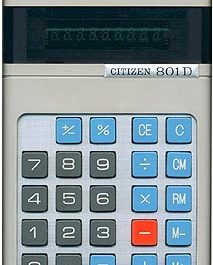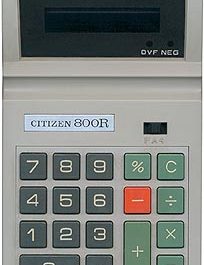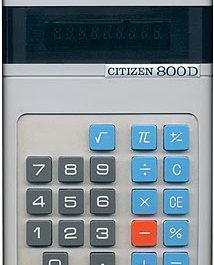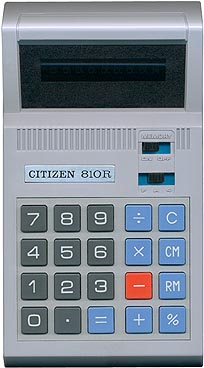
The Citizen 810R, released in 1974 is a sturdy device, equally at home on a desk or in hand and embodies the transitional period between bulky desktop machines and truly portable calculators.
Measuring 87mm x 150mm x 33mm and weighing a substantial 276g including its rechargeable batteries, the 810R was not designed for pocket carry. Instead, it came with a soft black plastic cover featuring a full-length zipper and a rope-like carrying strap, emphasizing its semi-portable nature.
The calculator’s design is quintessentially 1970s, with a two-tone grey plastic case and a prominently tilted green vacuum fluorescent display (VFD). This 8-digit display, manufactured by Futaba, includes additional symbols for overflow, negative numbers, and memory indication. Below the display, a black metallic sticker proudly bears the Citizen brand and model number, while nearby switches control decimal selection and memory functions.

At the heart of the 810R lies a Rockwell A1030PC microprocessor, a 42-pin chip that was cutting-edge for its time. The internal layout reveals a densely packed board with 17 transistors, 5 diodes, and various other components, showcasing the complexity of early electronic calculators.
The 810R’s feature set is relatively basic by modern standards but was quite capable for its era. It offers the four standard arithmetic functions, percentages, and a two-function switch for auto-accumulating memory. An additional switch allows users to toggle between fixed, floating, and financial decimal point modes.
One of the most intriguing aspects of the 810R is its use of arithmetic logic, also known as semi-Reverse Polish Notation (RPN). This input method, while less intuitive than the algebraic logic used in most modern calculators, was common in early electronic calculators and reflects the computational approaches of the time.
Logic:
- The clear (C) key functions as both a clear entry and clear all button
- Automatic constant function for multiplication and division only
- Arithmetic (semi-RPN) input mode
- Input overflow is suppressed after the 8th digit
- Negative numbers displayed with a “-” symbol, allowing full 8-digit negative numbers
- Overflow and divide-by-zero errors are indicated and recoverable
- Three decimal modes: floating, financial, and fixed (4-digit)
- Auto-accumulating memory when switched on
- Memory storage indicated by “~M~” symbol
- Suffers from the “pseudo fixed decimal bug” common in calculators of its era
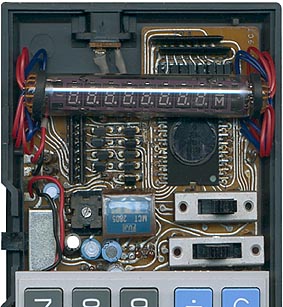
The Citizen 810R’s robust construction, innovative features, and quirky logic system make it a noteworthy piece of computing history. While it may seem cumbersome and limited by today’s standards, the 810R was a powerful tool for its time, bridging the gap between desktop and truly portable calculators. Its continued functionality decades later, with batteries that still hold a charge, is a testament to the quality of its construction and the enduring nature of these early electronic devices.
